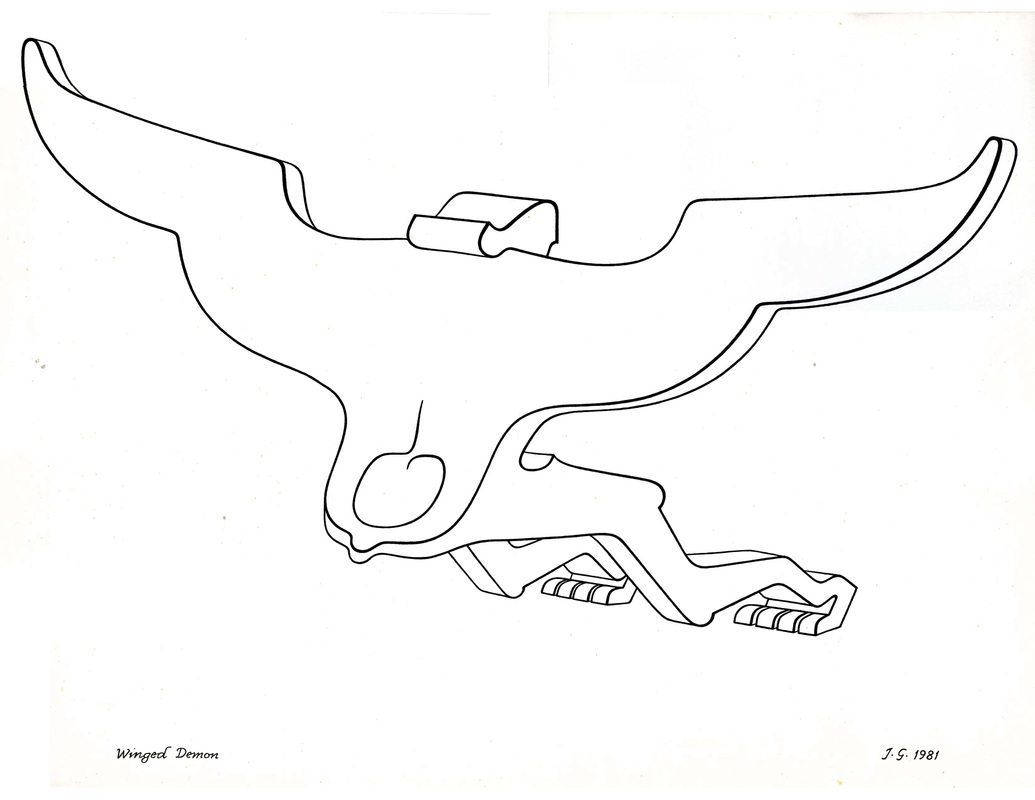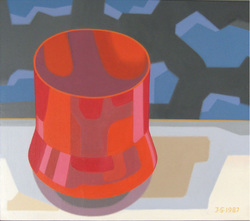|
In the early 1990s this was given first as a speech to a class at the Lancaster County Art Association, and in briefer form afterwards on a couple of other occasions. Some of the illustrations come from the text, others from references to physical works that Johannes brought with him, and one from live demonstration. (2nd of eleven sections) G. Perfection, Compromise and Wear
H. The Integrity and Wholeness of a Perfect Thing The constraints of compromise and wear are difficulties which we may dismiss once we have managed them as well as circumstance allows. But we can center ourselves so narrowly on practical utility that we are scarcely able to endure and live with our functional creations. Unsightliness – through irritating or distracting and thereby weakening the user – impairs the function of an object. Moreover, artifacts are not just with us when they do their work, but also at their idle periods. Thus, among their varied functions, that of giving satisfaction to the viewer who beholds them has to be included. An artifact is made completely – that is, wholly finished and in that sense perfect – when visual excellence and utility are joined. When a man-made thing thus embodies an optimal reply to each of the user’s sensible requirements, it will bear wholly the character of all that it is made to be. It will be itself. That is, within the constraints of its own integrity, it will be perfection, in quite a similar sense that geometric shapes also can be perfect. A circle, for example, will be perfect within the limits of its own identity, because it is unsurpassable in its character of circularity. I. The Excellence of Art Visual excellence is an attribute of all good art toward one especial function, namely, that of being seen. It is essential in both the applied as well as fine arts, and consists at least of two requirements.
of grapes and prefer blonde girls to brunettes. Just proportionality gives to us the unimpeded visual coherence of a thing and hence its ready legibility. (This should be demonstrated live.) 2. Clarity: However, clarity is an intrinsic property of the work itself and therefore no more dependent upon who can look at it with understanding than is the legibility of writing to be judged by those who do not know their letters. For clarity inheres in the exactitude of the artist’s reconstruction of his purpose in visible material form. Clarity brings illumination into our minds and is there loved by our understanding. Clarity does not mean an expression is directly understood but only that it is amenable to comprehension. However, since we mostly want to understand any subject we consider, we love lucidity for granting us what we desire. J. The Common Foundation The Basic Designs – both two and three dimensional – are a line of learning aimed at Visual Literacy pursued by students in every field of art but thereafter put to different uses. All able expression of visual literacy is valuable and deserves a place in art. But the different art disciplines do not, on that account, produce interchangeable results. 1. Pictorial Limitation: I cannot put my pictures to work to pour coffee or bicycle myself downtown. But, equally, I cannot put the artifacts suitable for these two uses to the assignments that pictures may perform. 2. Pictorial Expression:
2. Pictorial Expression (cont’d)
2. Pictorial Expression (cont’d)
Pictorial interpretation of Literature, Fantasy and Life is beyond the reach of objects of utility, which are expressive chiefly of the use to which we put them, and closely limited therefore to an excellence of visual form and the material service desired by the patron, without profound interpretive intention. 3. Artifacts in Numbers: The potential of an artifact is thus exhausted only if we regard it by itself. A work of Architecture with various details – inside as well as out – and its assembly of artifacts for every sort of use, especially indoors, can, overall, be far more than the sum of all these parts. They can give an eloquent articulation of the owners’ habits, character and will. Whole human lives express themselves that way. The discipline of Archaeology, from just such clues, endeavors to reconstruct entire cultures. Thus, artifacts in numbers – coherently selected and arrayed, achieve an expressive range that eludes them singly. For this breadth of creativity, apparently, was Architecture named “Queen of all the Arts” by Michelangelo. Artifacts can be as powerfully and as far expressive as products of the Fine Arts. But while the latter are able to achieve this purpose singly, artifacts themselves cannot. Yet, of the many times when a judgment of what will be better and what worse cannot be evaded, in this case we may let the question rest and strive to design better the objects of utility as well as nobler works of art. It is important only to thoroughly understand what each is all about. K. Two Definitions of Art
2. Defining the Purpose of the Making: Visual Art is a language for engaging the participation – not of our sense of hearing, but of sight – for sharing, by an apt assembly of the visual parts of color, form, and line, the artist’s intention, with our open eyes and receptive minds, so that we shall be enriched and, in the end, fulfilled. Comment: You might describe an artifact which you own and love that is beautiful and expressive - a work of art in itself . . .
0 Comments
In the early 1990s this was given first as a speech to a class at the Lancaster County Art Association, and in briefer form afterwards on a couple of other occasions. Some of the illustrations come from the text, others from references to physical works that Johannes brought with him, and one from live demonstration. (FIRST of eleven sections) I The Artifact and the Art Object A. Rules for Right Making in Utility and Art In past times distinctions were drawn between products of the Fine Arts and humble Objects of Utility, adding to the latter ever the inferior rank. Much thinking in this century turned this around, proclaiming the well-made artifact the equal of the work of art and, in all essential ways, indistinguishable from it. The difficulty may not be amenable to any final settlement. There is a common good desired of them both: We want our furnishings as well as our pictures to be beautiful. But their capabilities and purposes can also differ widely; and that needs to be accounted for before this search for understanding ends. Yet, for our start it will be helpful that the ground rules for creating a good product govern equally the object of utility and one existing solely for its beauty – the Applied as well as the Fine Arts. B. John Benson’s Course and the Twin Purposes of All Instruction Undergraduates at Rhode Island School of Design in the 1950s studied during one semester a subject called Philosophy of Design. The course was taught by a great man, John Howard Benson. It was beautifully organized, and ably introduced us to a domain of intellectual concern that few artists ever get to know. Also, it fulfilled better than most others the twin purposes of all instruction:
C. Ways of Delivering the Wrong Results When an otter lies upon its back and opens a mussel by breaking the casing with a stone, or a raptor rises to some height and drops its catch to shatter on the ground below, or again, an early hominid seized a rock to cleave with it the brain-case of his game, the deeds appear identical in their complexity of mental action. But they are most dissimilar in their cultural and, in the end, historic consequences. Man alone evolved to overcome, to an extent, the specific limits all other species failed to breach. These, however, remain the causes of inferior work at the hands of man, to the present day. They are:
D. The Worthwhile and Essential Callings of Man’s Life
E. The Causes of Things Made There are reasons, or causes, why Man-Made Things Exist
and of the materials to each other. Techniques are the union of the Material and Efficient Causes. Materials properly chosen for their purpose are shaped according to what the right tools and materials can suitably be made, and want, to do for a desired end. 4. Formal Cause: The solution of the problem and its final form are achieved in Stages. The Stages are reductions, that is, Abstractions derived from the problem posted by the patron. Stages constitute the successive images to which the materials must by shaped. [Other Causes than those cited as Antecedents of Results –from notes at end of essay:
F. Stages as Instrumental Intermediate Forms
knowledge, will, and skill, but also inventive sensibility, is brought to bear to set the correct milestones in their places as the Work Path gradually unfolds. It is here, when we must rely on our uncertain intuitions, that we cannot altogether escape our own uneasiness of mind. 3. The last of the abstractions that we call a Stage is the Final Form and conclusion of the worker’s effort. It represents perfection as a thing complete and thoroughly constructed. Perfection is here not an attribute divine, but must be rightly understood as a property of man-made things within their range of possibilities, that is, within the impediments or limits of the job. When the last possible duty is faithfully performed, perfection as achieved because we can do no more – the final chore and last detail. Comment:
Perhaps you can comment from work you have done in Arts, Crafts or other projects using Stages as Intermediate Forms . . . . |
A Blog containing longer text selections from essays by Johannes, on art, philosophy, religion and the humanities, written during the course of a lifetime. Artists are not art historians. People who write are not all learned scholars. This can lead to “repeat originality” on most rare occasions. When we briefly share a pathway of inquiry with others, we sometimes also must share the same results.
Categories
All
Archives |
| von Gumppenberg | Johannes Writes |
|
|













 RSS Feed
RSS Feed